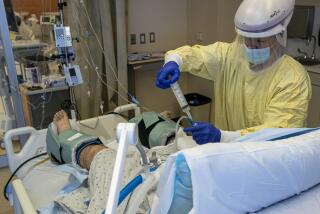More Disabled Should Be Urged to Return to Work, Federal Study Says
- Share via
WASHINGTON — Despite the fact that as many as three out of 10 severely disabled people may be good candidates to return to work, few do, a new report by the General Accounting Office shows. And with federal support for the disabled ballooning, the Social Security Administration needs to take action to control costs by getting more disabled people back on the job, said the GAO, the investigative arm of Congress.
Based on studies of how disabled benefits are handled in the private sector and in Sweden and Germany, the GAO recommended a major restructuring of the way the government distributes $53 billion in support payments. More than 6 million people receive benefits from the Social Security disability program or the Supplemental Security Income program. SSI is an income-tested program also administered by the Social Security Administration.
The report said that less than 0.5% of Social Security disability beneficiaries “ever leave the disability rolls by returning to work,” and the SSA “focuses little attention on returning beneficiaries to the workplace.”
“If an additional 1% of the 6.3 million beneficiaries were to leave SSA’s disability rolls by returning to work, lifetime cash benefits would be reduced by an estimated $2.9 billion,” it found.
*
The GAO proposed that the Social Security Administration develop a comprehensive return-to-work strategy and “intervene as soon as possible” after the onset of disability to promote the return to work.
Such intervention is crucial because “long absences from the workplace are believed to lead to a disability mind-set--a condition of discouragement in which the disabled workers, believing they will not be able to return to work, lose the motivation to try,” the report said.
One study cited by the GAO emphasized that it is best to identify within “days or even hours after a disabling event occurs” those who eventually may be able to return to work. This helps the worker develop an expectation that he or she can and will do so. Sweden and Germany take that approach, the GAO said.
The agency also said the priority today in the two big U.S. programs “is to determine the eligibility of applicants to receive cash benefits, not to assess their return-to-work potential.”
Some officials say that part of the reason Germany and Sweden take a different approach is that U.S. laws allow people to receive benefits only if they have the most serious, permanent-type disabilities. So, according to the Social Security Administration, there is less reason for immediate rehabilitation than in Europe, where numerous people with lesser disabilities receive benefits and are routinely assisted with return-to-work help.
*
Even so, the GAO’s position is that U.S. programs could do better on rehabilitation, quickly identifying potential return-to-work beneficiaries and starting rehabilitation and work-readiness steps, while enlisting support of employers.
The GAO also recommended that the United States structure disability benefits to encourage return to work and deal with people’s fear of “losing the security of a guaranteed monthly income and medical coverage.”
Although the rules allow such people trial work periods without loss of medical benefits or total loss of cash benefits for a period after resuming work, because of “weaknesses in the way these guarantees are designed and implemented,” the GAO said, “they have not encouraged many beneficiaries to attempt to return to work.”
The Social Security Administration, in a comment on the GAO’s findings, said it is taking steps to encourage rehabilitation but that the steps proposed by the GAO would require major changes in the law and re-orientation of the entire disability program. Commissioner Shirley S. Chater said “SSA cannot act alone.”
*
To develop and operate a whole new system stressing rehabilitation and jobs from the outset of a person’s disability would require participation of “all appropriate federal and state government agencies, private rehabilitation vendors, insurance companies, employers,” and the disabled and their advocacy groups, Chater said.
Unlike the European programs, she said, “SSA’s disability programs are designed to be cash benefit programs for individuals with long-term disabilities, not return-to-work programs.” In Sweden and Germany, Chater said, involvement of private employers in rehabilitation that is integrated with government programs is legislatively mandated.
More to Read
Sign up for Essential California
The most important California stories and recommendations in your inbox every morning.
You may occasionally receive promotional content from the Los Angeles Times.













